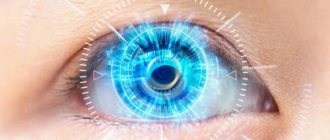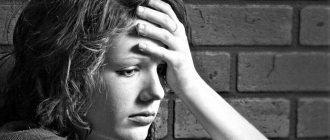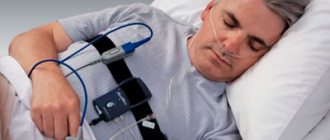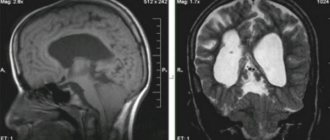Types of paralysis
There are a couple of main classifications of the described disease. The first is in terms of its etiology:
- central (spastic), as the name suggests, occurs as a result of damage to the central nervous system and contributes to muscle hypertonicity;
- peripheral (flaccid) is a consequence of damage to the nervous system in the periphery and reduces the tonic characteristics of muscles up to atrophy, leading to their thinning and exhaustion.
Based on the location of paralysis, the following types are identified:
- monoplegia – paralysis of a single limb;
- hemiplegia – paralysis of the arms and legs located on one side of the body, which can paralyze the same part of the face;
- paraplegia – dysfunction of exclusively upper or exclusively lower extremities;
- tetraplegia – dysfunction of four limbs.
- In addition, paralysis can be temporary or permanent.
Treatment
Photo: golovazdorova.ru
Treatment is primarily aimed at eliminating the factor that caused the development of paralysis. For example, if a tumor is present, surgical intervention is required, during which the formation is removed. In the case of an infectious disease of the nervous system of bacterial etiology, antibacterial agents are prescribed. The choice of a specific antibiotic is made based on the data obtained on the sensitivity of pathogenic microorganisms.
Drugs that improve the conduction of impulses along nerve fibers are also used. In addition, so-called neurotrophic drugs are prescribed, the action of which is aimed at restoring nervous tissue. To improve metabolic processes in the brain and spinal cord, vascular drugs are prescribed. As you know, B vitamins improve neuromuscular conduction, which is why periodic administration of these drugs is rational.
For peripheral paralysis, physiotherapeutic procedures may be prescribed. They help improve blood circulation, stimulate metabolic processes, and help restore lost function. In this case, the following physiotherapy methods are used:
- Diadynamic therapy is a physiotherapeutic method of treatment based on exposure to electric current with a frequency of 50 – 100 Hz;
- electrophoresis is a physiotherapeutic procedure that involves introducing a medicinal product into the body tissues through intact skin, carried out using a direct electric (galvanic) current;
- Magnetic therapy is a method of physiotherapeutic treatment based on the use of a static magnetic field.
In addition, it is important not to forget to constantly exercise paralyzed muscles, since prolonged periods of muscle inactivity lead to irreversible loss of their functions.
Causes
As noted above, paralysis does not come on its own. Its manifestation is caused by the development of any disease in the patient. The most common underlying causes of paralysis are outlined below.
- spinal and cerebral injuries;
- poisoning (heavy metals, salts of heavy metals, household and industrial poisons, alcoholic and narcotic substances, pharmacological compounds, etc.);
- oncological formations, including cancer;
- serious infections that negatively affect all organs (meningitis, polio, tuberculosis, syphilis, etc.);
- metabolic disorders, metabolic processes;
- botulism is an extremely serious infectious disease that leads to injury to the nervous system (medulla oblongata and spinal cord); caused by the entry into the body of a spore-forming rod, the product of which is botulinum toxin;
- non-compliance with proper nutrition standards;
- neglect of the rules of a healthy lifestyle;
- hereditary pathologies that negatively affect the functioning of the central and peripheral nervous system; these pathological anomalies often accompany various disorders of motor coordination;
- injuries sustained by the baby during childbirth;
- blood flow disturbance;
- abscess formations in the spinal cord or brain;
- inflammation of the spinal cord (myelitis) and brain (encephalitis);
- Guillain-Baré syndrome is an acute autoimmune disorder;
- transient ischemic attacks - temporary disruption of blood flow;
- demyelination (decay of the myelin sheath, which is responsible for the electrical insulation of neurons and the speed of information transmission between them) as a result of encephalomyelitis, multiple sclerosis or another disease, possibly of a chronic nature;
- myasthenia gravis – an autoimmune ailment characterized by atypically accelerated fatigue of muscle fibers; the symptoms of the indicated disease progress after a person undergoes active physical activity and weaken after rest;
- myopathy is a chronic pathology that affects neuromuscular cells;
- epilepsy is a neurological disorder characterized by spontaneous seizures;
- A stroke is a sudden interruption in the blood supply to the brain.
Unilateral types of paralysis (monoplegia and hemiplegia) most often occur as a result of a stroke. Moreover, if there is a disruption in the blood supply to the left hemisphere of the brain, then the right side of the body becomes paralyzed, and vice versa.
In medical practice, there are quite a large number of examples when paralysis turned out to be a consequence of psychological problems, a neurotic disorder. The psychogenic nature of the syndrome necessarily requires specific rehabilitation measures, in particular, work with a psychologist, psychotherapist or psychiatrist.
Cerebral palsy (CP) - symptoms and treatment
For the treatment of cerebral palsy, it is important to have an early start, an individual approach, continuity and succession at different stages (when each specialist supports and improves the results achieved by the previous doctor). Treatment is combined with educational work, occupational therapy (medical rehabilitation that teaches the patient to restore or acquire everyday skills, occupational therapy). It is necessary to include the child’s family members in the work to comply with the principle of continuity [5].
There are several main approaches to the treatment of cerebral palsy:
- Method of functional therapy - kinesiotherapy, exercise therapy, physical therapy, hardware kinesiotherapy, functional massage techniques.
- Conservative orthopedic treatment - orthosis, casting, postural management (use of technical means of rehabilitation - verticalizers, seat supports).
- Drug treatment with oral antispastic drugs.
- Botulinum toxin preparations , which belong to the group of local muscle relaxants and reduce spasticity. The drug relaxes the spastic muscle into which it was injected. They do not have a systemic effect, that is, they do not affect internal organs and the brain, but act only at the injection site.
- Intrathecal (injection into the bone marrow membrane) of baclofen using a pump is a constant injection into the space between the hard shell of the spinal cord and the yellow ligament using a pump into the patient’s body of the drug “Baclofen”, which has a systemic effect and relaxes all spasmodic muscles. The big disadvantage of the drug is the need to monitor the dose and refill the pump. Pump installation is available only in large federal and territorial clinics.
- Orthopedic surgery includes a large number of different operations that are aimed at lengthening muscles, restoring the hip joint in case of dislocation, forming a correct arch of the foot and full support of the foot, restoring a more even posture in case of scoliosis.
Treatment approaches are used depending on the severity of cerebral palsy and the age of the child. Functional therapy, conservative orthopedic treatment and postural management can be used from a very early age. Botulinum therapy is usually used from 2 years of age . The use of these approaches in combination with continuous long-term treatment and correction of all comorbid (associated) disorders ensures the high effectiveness of complex treatment. Oral antispastic drugs for cerebral palsy are often used to a limited extent due to the development of systemic side effects.
When treated with botulinum toxin type A (BTA), the maximum possibility of disease modification is observed at the age of 2-5 years . At older school age, botulinum therapy helps to solve local motor problems, reduce pain from prolonged spasms, facilitate care for patients with severe motor disorders, and also maintain the body in a sitting or standing position [8].
Kinesitherapy is a method of teaching and restoring a child’s motor activity through repeated repetitions of physiological movements, taking into account the ontogenesis of motor skills. The most effective methods are Vojta therapy, Bobath therapy, and PNF therapy [7].
An integral part of the rehabilitation process for children with cerebral palsy is psychological and speech therapy assistance and social adaptation. It consists of teaching children speech skills, communicating with other children around them, developing fine motor skills, and teaching self-service skills.
Orthopedic treatment helps eliminate contractures and deformities, as well as create a rational position for the child. Treatment includes special therapeutic positions during rest and sleep hours, staged correction of contractures using plaster splints and circular bandages. Of great importance is the prevention of secondary deformations and contractures in children during the period of rapid growth at 5-7 years and then from 12-15 years , when there is a tendency to the formation and recurrence of contractures.
For persistent contractures, surgical treatment is performed, but not earlier than 3 years of age , since active bone growth occurs before this and with early surgical treatment, relapses may occur due to the growth of the child. In modern neuroorthopedics, they try to delay surgical treatment as long as possible so as not to cause setbacks in the future.
In the postoperative period, the development of optimal positions of the body and limbs, rational compensatory devices, and the development of self-care skills continues. Prosthetic and orthopedic support is essential - the selection and adaptation of special auxiliary devices that help correct posture: verticalizers, seat supports, walkers, splints, devices for the lower limbs and torso [7].
Symptoms and complications
Since the root causes of paralysis can be completely different, its symptoms are quite diverse.
Paralysis that is just beginning to develop is characterized by loss of sensation in the limbs and impaired functioning of some muscles. Over time, the patient stops feeling the painful effects. Due to impaired blood flow in the affected area, nearby internal organs lack nutrients that ensure the stability of their structure and functionality. When it comes to damage to the neural centers responsible for the management of natural needs, the paralyzed person is no longer able to control urination and defecation.
A patient suffering from paralysis should be especially closely monitored for changes in well-being. When paralysis is provoked by reasons from the organic sphere, it is accompanied by reflex changes, disorders of the tonic state of muscles, including atrophic ones. However, with a temporary form of paralysis, there are no changes in muscle tone and reflex characteristics in the tendons.
With spastic paralysis of the lower extremities, which appears when the central motor neuron is damaged, atypical muscle reflexes occur. Their excitability increases significantly, and involuntary movements may occur. Sometimes this subtype of paralysis is accompanied by loss of speech abilities.
The peripheral, or flaccid, type of paralysis is characterized by atonic changes in the muscles (they relax very much, regardless of the will of their owner), which tend to reach their atrophy, as well as the disappearance of reflexes. It is characterized by a deeper degree of damage to the musculoskeletal system. His victim is not only unable to move, but is also doomed to constantly remain in a lying position. Typically, such paralysis occurs when the spinal cord is damaged in the lumbosacral region and can be an unpleasant aggravating addition to the spastic paralysis described above.
In addition to the already depressing situation with paralysis, concomitant diseases begin to develop. Complications of paralysis include various pathologies of the cardiovascular system, respiratory organs, bones and muscles.
Diagnostics
Before treatment for leg paralysis begins, it must be properly diagnosed. In this case, an integrated approach is important.
Diagnosis of paralysis must be made by a highly qualified doctor - an osteopath, neurologist, neuropathologist or neurosurgeon.
The doctor checks his patient’s reflexes, muscle tone, and conducts various tests. It is extremely important to rule out other diseases that have similar symptoms. In particular, it is necessary to exclude Bell's palsy, multiple sclerosis, and cerebral palsy.
Bell's palsy is a paralysis of the facial nerve, resulting in paresis of the upper and lower parts of the face. Mechanically, it is associated with swelling of the facial nerves caused by immune or viral pathology. Even the notorious herpes virus can act as the latter.
In multiple sclerosis, the myelin cells in the brain or spinal cord are affected. This is a type of chronic autoimmune disease.
Cerebral palsy is considered almost the most severe illness in the field of neurology. When it occurs, damage to the brain occurs, or the latter simply remains underdeveloped, as well as a violation of motor functions, the functioning of the speech center, the vestibular apparatus, a deterioration in learning, perception, and adaptive skills.
Moving away from the topic, we note that the Osteopathy Center successfully works with the above problems. Clients with such diagnoses, if not completely cured, receive serious relief and noticeable progress during rehabilitation.
Instrumental diagnostics is a diagnostic technique using the latest and well-proven apparatus and devices.
Such diagnostic methods include the well-known ones:
- computed tomogram - is a complex method of processing and measuring tissue density using a computer;
- magnetic resonance imaging – allows you to thoroughly examine the areas of the back and head and clarify the diagnosis;
- X-ray examination;
- electroneuromyogram - to assess bioelectroactivity, the speed of nerve impulses;
- electroencephalogram - for differential assessment of the electrical activity of cerebral zones;
- neurosonographic examination - is another non-invasive study, makes it possible to study the functioning of the brain and the condition of the tissues inside the skull, carried out by emitting ultrasonic waves; Suitable for use only in very young children, whose fontanel is not yet covered with a bone layer.
You will also need to take blood and urine tests, check the level of leukocytes and red blood cells, the fact of intoxication, and the presence of an inflammatory focus.
4.Treatment
Ready-made recipes, protocols, treatment regimens for paresis and paralysis, universal for all possible cases and clinical situations, are, of course, impossible. The therapeutic strategy is always determined by diagnostic results and many individual indicators; it is always, if possible, etiopathogenetic (aimed at eliminating the cause) and, if possible, minimally invasive. But even with this, the only correct, approach, the result can not always be confidently predicted. Sometimes mobility is gradually restored with virtually no treatment, but the other way around also happens: the most intensive and seemingly 100% justified treatment, which has long proven its effectiveness, does not bring the desired result: paralysis remains completely or partially until the end of life, and sometimes progresses, involving everything new structures and systems (as observed, for example, with amyotrophic lateral sclerosis and other atrophic processes). In some cases, the method of choice is conservative therapy, in others the simplest, most effective and, oddly enough, safe treatment is neurosurgical intervention. Particular mention should be made of the group of physiotherapeutic and “non-traditional” methods. It is in this area, i.e. In the rehabilitation of patients with paralysis and paresis, the role of massage, exercise therapy, physiotherapy, acupuncture and other similar procedures is extremely important. However, their capabilities should be assessed sensibly, without elevating them to the rank of miracles and without forcing their use: the result may turn out to be insignificant or directly opposite to the desired one. It is equally important to be critical of the countless healers, healers, geniuses, enthusiasts and simply outright charlatans who strive under the slogans of miraculous healing.
But the main thing: at the first signs of unusual muscle weakness, numbness, decreased sensitivity, any limitation in mobility and/or range of usual movements, consult a doctor immediately. It’s really not worth waiting until a mild and possibly transient (at least curable) “paresis” turns into full-blown and irreversible paralysis.
Prevention
The preventive measures that doctors recommend in this case are extremely simple. It is necessary to lead a healthy lifestyle, eat right, drink plenty of clean water, exercise, vigilantly listen to your well-being, monitor your health, get enough sleep and be less nervous.
Preventive general health sessions in an osteopractor’s office will help prevent all sorts of problems leading to paralysis, as well as identify and eliminate them at the very beginning of their destructive effect on the body.











